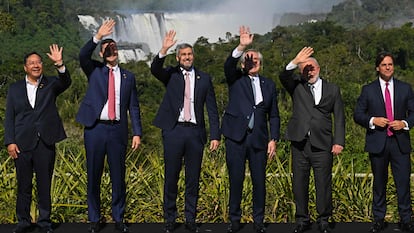The chess match of trade
Uruguay is the country the United States prefers to include in expanding the treaty between the United States, Mexico and Canada. The Americans’ interest in the tiny South American nation is explained by its ambition to integrate Mercosur

Last Wednesday, Luis Lacalle Pou, the president of Uruguay, once again broached the urgency with which his country intends to liberalize trade between Mercosur and other countries and regions. His comments were made at a meeting among the presidents of the Mercosur trade bloc held in the Argentine city of Puerto Iguazú. Lacalle’s argument was motivated by the reluctance of Brazil and especially Argentina to implement the integration agreement reached with the European Union in 2019. But the Uruguayan position goes much further; it is a major player in the competition and tensions caused by the rivalry between the United States and China, which are projected onto Latin America.
Mercosur is a customs union, which means a common external tariff applies to trade with third parties. Therefore, any international complementation treaty must be signed by its four members: Brazil, Argentina, Paraguay and Uruguay. The very long delay in making trade more flexible has led Uruguayans to hint that they are ready to leave the bloc, or at least reduce the country’s level of participation so that it can be in a position to sign bilateral treaties.
To understand the pressure on Uruguay, one must look at the world map. This tiny South American country received an offer from China to sign a free trade agreement independent of its other three Mercosur partners. It is unlikely that this audacious move by the Chinese is guided by its attraction to the Uruguayan market, which is made up of only three and a half million people. China’s seduction of Uruguay is intended as a challenge to Brazil and Argentina.
And the Brazilians have reacted, especially in recent months. As soon as President Lula da Silva returned to power, he began a systematic rapprochement with Uruguay through cooperation and investments, especially in infrastructure. The Brazilian government has always defended its role as a regional leader, which makes it very resistant to the intrusion of foreign powers in its sphere of influence.
The Chinese understand this. In April, Uruguayan Foreign Minister Francisco Bustillo traveled to Beijing and met with Vice President Han Zheng, Foreign Minister Qin Gang and International Trade Representative Wang Shouwen. They all told him that they were still interested in reaching an agreement but preferred to wait until it could be signed with Mercosur to avoid problems.
These Chinese efforts are prompting a number of reactions in the United States. The U.S. elite is increasingly aware that a major battle in the conflict with China is being fought in Latin America, which is a major supplier of food, minerals and energy to meet demand in Asia.
The general framework of this dispute, as interpreted by Joe Biden’s administration, was presented by National Security Council advisor Jake Sullivan in a speech at the Brookings Institution on April 27. That presentation was perhaps the most forceful and innovative presentation by a Washington official to explain the current challenges as the administration sees them. Sullivan spoke of the Washington Consensus’s failures, the need to build another industrial model and the urgent necessity to assist developing countries by reformulating the role of multilateral lending agencies and the Global Infrastructure and Investment Partnership (GIIIP) proposed by the Group of Seven. The express purpose of these initiatives is to counteract the Chinese advance, especially in Latin America, through the One Belt, One Road program.
Other programs formulated by Congress pursue that same purpose. Bill Cassidy, a Republican senator from Louisiana, and his Democratic colleague from Colorado, Michael Bennet, presented a bill called America’s Act, which consists of a plan to expand trade on a continental scale. On June 13, the two presented their plan at the Atlantic Council Latin American Center at a meeting entitled Closer to Home: Bringing Supply Chains Back to the Americas. Bennet said: “For decades, Washington has failed to create any comprehensive policy or offer a compelling alternative to Chinese investment in the region. While we’ve been busy elsewhere, China has rushed to fill the void with a surge of trade, investment, and technology. We’ve already seen these relationships pose a long-term threat to local industries, minerals, environment, the rule of law throughout the Western Hemisphere, and I think the Americas Act offers an opportunity for the United States to renew our partnerships across Latin America and the Caribbean and embrace our values together in a shared struggle for democracy and for prosperity.”
Among its numerous proposals, the program includes creating a $40 billion credit fund administered by the Secretary of the Treasury; founding an Investment Corporation for the Americas, with preferential loans, guarantees and insurance; establishing an Enterprise Fund to extend private loans and guarantees for companies in the region; creating a new undersecretary for trade with the countries of the Americas and so on.
In Cassidy and Bennet’s project, which Democrats will pursue with more conviction if Biden is reelected, there is a significant line item. It concerns the extension of the US-Mexico-Canada Agreement (USMCA), an updated version of NAFTA, to other Latin American countries. Academics are increasingly recommending this strategy, which is intended to circumvent the resistance in Congress to approving new free trade agreements, especially among left-wing Democratic legislators.
Here, we can clearly see how the conflict between the United States and China is playing out in the region through a commercial chess match. The preferred country for expanding the USMCA is Uruguay. As in the case of the Chinese, the Americans’ interest in the tiny South American country can be explained by its ambition to integrate Mercosur. The invitation to join the USMCA is a simpler way to move toward the goal Bill Clinton set in 1994 when he inaugurated the Free Trade Area of the Americas, which perished at the Summit of the Americas in Mar del Plata, in 2005, at the initiative of Lula and Argentina’s Néstor Kirchner.
In the 19th century, the British saw Uruguay as a crucial actor in their policy toward southern Latin America, a piece through which it could push certain dynamics. Today, China and the United States are disputing access to the same country as a way to make Mercosur’s extreme protectionism more flexible. History certainly repeats itself.
Sign up for our weekly newsletter to get more English-language news coverage from EL PAÍS USA Edition
Tu suscripción se está usando en otro dispositivo
¿Quieres añadir otro usuario a tu suscripción?
Si continúas leyendo en este dispositivo, no se podrá leer en el otro.
FlechaTu suscripción se está usando en otro dispositivo y solo puedes acceder a EL PAÍS desde un dispositivo a la vez.
Si quieres compartir tu cuenta, cambia tu suscripción a la modalidad Premium, así podrás añadir otro usuario. Cada uno accederá con su propia cuenta de email, lo que os permitirá personalizar vuestra experiencia en EL PAÍS.
¿Tienes una suscripción de empresa? Accede aquí para contratar más cuentas.
En el caso de no saber quién está usando tu cuenta, te recomendamos cambiar tu contraseña aquí.
Si decides continuar compartiendo tu cuenta, este mensaje se mostrará en tu dispositivo y en el de la otra persona que está usando tu cuenta de forma indefinida, afectando a tu experiencia de lectura. Puedes consultar aquí los términos y condiciones de la suscripción digital.
More information
Archived In
Últimas noticias
There is as much life left to discover on planet Earth as that which is already known
Dozens presumed dead, around 100 injured in fire at Swiss Alps bar during New Year’s celebration
Is porn for women different from conventional porn? We spoke to those who make it
Cartagena de Indias is sinking: What can the city do to mitigate it?
Most viewed
- Sinaloa Cartel war is taking its toll on Los Chapitos
- Reinhard Genzel, Nobel laureate in physics: ‘One-minute videos will never give you the truth’
- David King, chemist: ‘There are scientists studying how to cool the planet; nobody should stop these experiments from happening’
- Oona Chaplin: ‘I told James Cameron that I was living in a treehouse and starting a permaculture project with a friend’
- The Interoceanic Train, the Mexican alternative to the Panama Canal











































